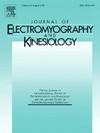Diagnostic value of EMG of sternocleidomastoid and trapezius in assessing bulbar lower motor neuron involvement in amyotrophic lateral sclerosis patients
IF 2.3
4区 医学
Q3 NEUROSCIENCES
引用次数: 0
Abstract
The diagnostic value of needle electromyography (EMG) of sternocleidomastoid (SCM) and trapezius (TRA) in assessing bulbar lower motor neuron involvement (LMN) remained controversial. 203 sporadic amyotrophic lateral sclerosis (ALS) patients were enrolled to assess the correlation between EMG abnormalities in SCM and TRA and bulbar LMN involvement. Additionally, difference analysis and diagnostic consistency analysis of EMG abnormalities in GEN (genioglossus), SCM, and TRA were compared. Finally, separate effects of EMG abnormalities in GEN, SCM, and TRA on diagnostic gradings were examined according to the Awaji-Shima criteria. 22 (18.2 %) and 65 (53.7 %) patients without bulbar LMN involvement showed EMG abnormalities in SCM and TRA. In contrast, 19 (23.2 %) and 11 (13.4 %) patients with bulbar LMN involvement showed normal EMG results in SCM and TRA. Multivariate logistic regression analyses showed that both EMG abnormalities in SCM and TRA were correlated with bulbar LMN involvement (P < 0.001). SCM showed electrophysiological characteristics similar to GEN when compared to TRA. However, TRA (67.0 %) showed significantly higher rates of EMG abnormalities than SCM (41.9 %) and GEN (40.4 %) in the whole study population. Reclassified diagnostic gradings showed no significant difference when evaluating EMG abnormalities in individual muscles to indicate bulbar LMN involvement (P = 0.072). EMG abnormalities in SCM and TRA could not fully represent bulbar LMN involvement but were correlated with it. It’s advisable to prioritise TRA as a better option when a patient cannot tolerate an EMG examination in the GEN. To enhance the diagnostic evaluation, an EMG examination of GEN could be served as the last choice.
胸锁乳突肌和斜方肌肌电图对肌萎缩侧索硬化症患者球下运动神经元受累的诊断价值
胸锁乳突肌(SCM)和斜方肌(TRA)的针肌电图(EMG)在评估球下运动神经元受累(LMN)中的诊断价值一直存在争议。203例散发性肌萎缩性侧索硬化症(ALS)患者被纳入研究,以评估SCM和TRA肌电图异常与脊髓LMN受累的相关性。此外,比较GEN (genigenogssus)、SCM和TRA的肌电异常的差异分析和诊断一致性分析。最后,根据Awaji-Shima标准,分别检查GEN、SCM和TRA的肌电异常对诊断分级的影响。22例(18.2%)和65例(53.7%)未受累的患者在SCM和TRA表现出肌电异常。相比之下,19例(23.2%)和11例(13.4%)受累于球LMN的患者在SCM和TRA上的肌电图显示正常。多因素logistic回归分析显示,SCM和TRA的肌电图异常与球部LMN受累相关(P <;0.001)。与TRA相比,SCM表现出与GEN相似的电生理特征。然而,在整个研究人群中,TRA(67.0%)的肌电异常率明显高于SCM(41.9%)和GEN(40.4%)。重新分类的诊断分级在评估单个肌肉的肌电图异常以指示球LMN受累时没有显着差异(P = 0.072)。SCM和TRA的肌电异常不能完全代表LMN受累,但与之相关。当患者不能忍受GEN肌电图检查时,建议优先考虑TRA作为更好的选择。为了提高诊断评价,GEN肌电图检查可以作为最后的选择。
本文章由计算机程序翻译,如有差异,请以英文原文为准。
求助全文
约1分钟内获得全文
求助全文
来源期刊
CiteScore
4.70
自引率
8.00%
发文量
70
审稿时长
74 days
期刊介绍:
Journal of Electromyography & Kinesiology is the primary source for outstanding original articles on the study of human movement from muscle contraction via its motor units and sensory system to integrated motion through mechanical and electrical detection techniques.
As the official publication of the International Society of Electrophysiology and Kinesiology, the journal is dedicated to publishing the best work in all areas of electromyography and kinesiology, including: control of movement, muscle fatigue, muscle and nerve properties, joint biomechanics and electrical stimulation. Applications in rehabilitation, sports & exercise, motion analysis, ergonomics, alternative & complimentary medicine, measures of human performance and technical articles on electromyographic signal processing are welcome.

 求助内容:
求助内容: 应助结果提醒方式:
应助结果提醒方式:


